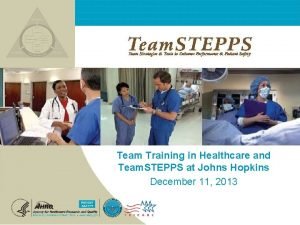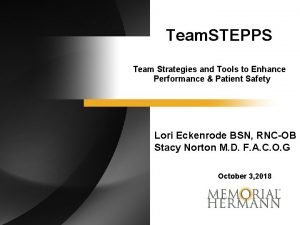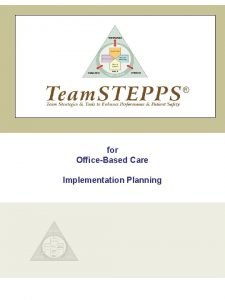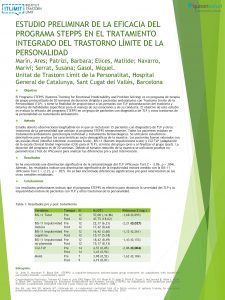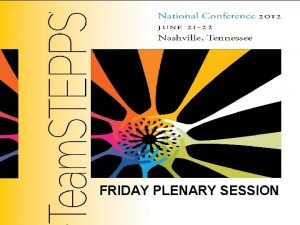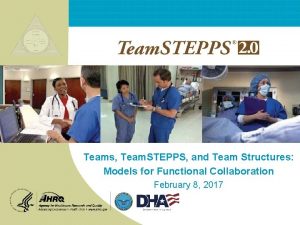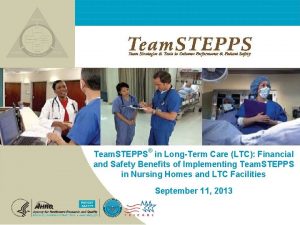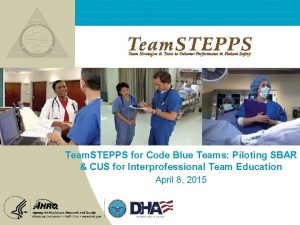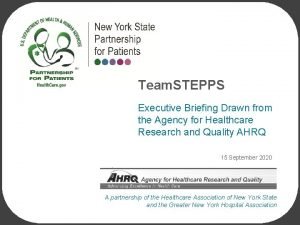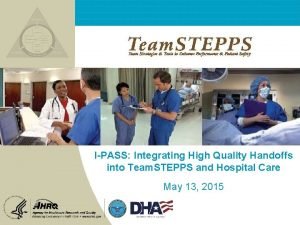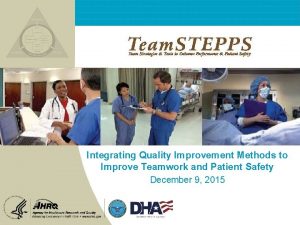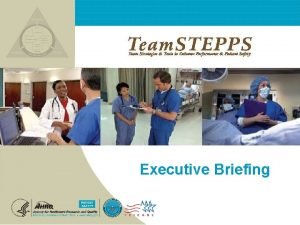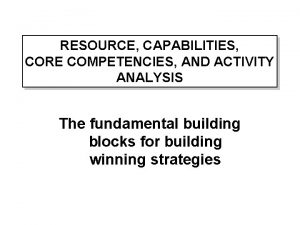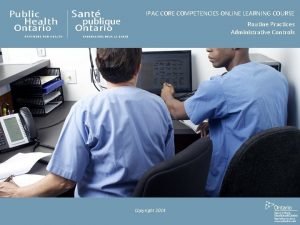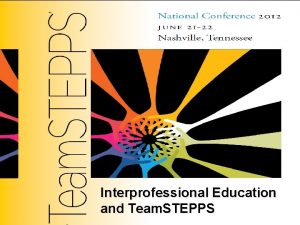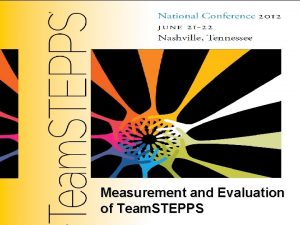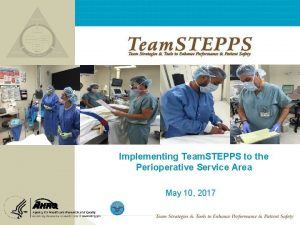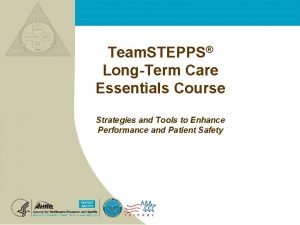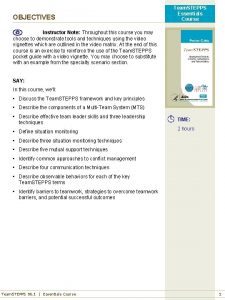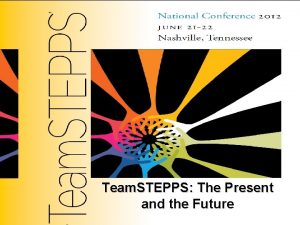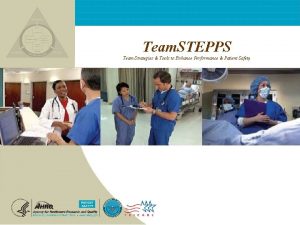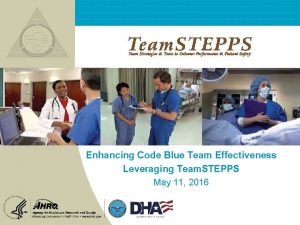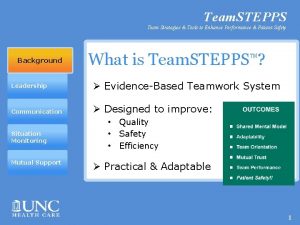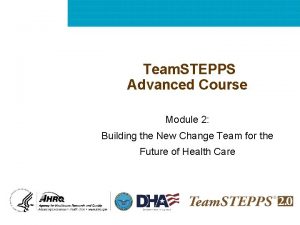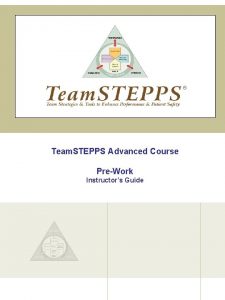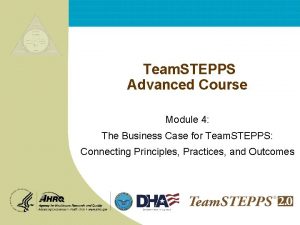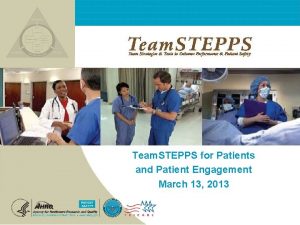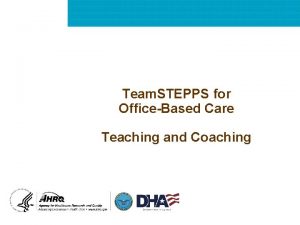Essentials Course Essentials Framework and Competencies Team STEPPS



























- Slides: 27

Essentials Course

Essentials Framework and Competencies Team. STEPPS is composed of four teachablelearnable skills: Leadership, Situation Monitoring, Mutual Support, and Communication: the core of the Team. STEPPS framework. The arrows depict a two-way dynamic interplay between the four skills and the team-related outcomes. Interaction between the outcomes and skills is the basis of a team striving to deliver safe, quality care. Encircling the four skills is the resident care team, which not only represents the resident and direct caregivers but also those who play a supportive role within the health care delivery system. …Team. STEPPS is an evidence-based framework to optimize team performance across the health care delivery system. LTC Essentials Page 2 TEAMSTEPPS 05. 2

Essentials Key Principles Team Structure Identification of the components of a multi-team system that must work together effectively to ensure resident safety Communication Structured process by which information is clearly and accurately exchanged among team members Leadership Ability to maximize the activities of team members by ensuring that team actions are understood, changes in information are shared, and team members have the necessary resources Situation Monitoring Process of actively scanning and assessing situational elements to gain information or understanding, or to maintain awareness to support team functioning Mutual Support Ability to anticipate and support team members’ needs through accurate knowledge about their responsibilities and workload LTC Essentials Page 3 TEAMSTEPPS 05. 2

Essentials Multi-Team System (MTS) for Resident Care Safe and efficient care involves the coordinated activities of a multi-team system LTC Essentials Page 4 TEAMSTEPPS 05. 2

Essentials SBAR A technique for communicating critical information that requires immediate attention and action concerning a resident’s condition Situation — What is going on with the resident? "I am calling about Mrs. Mary Smith, 88 years old, who has had a change in condition. She has a new onset of confusion, has developed a cough, ate very little today, and has been refusing all extra fluids. “ Background — What is the clinical background or context? “Mrs. Smith has type 2 diabetes, arthritis, osteoporosis, cataracts, stress incontinence, and mild cognitive impairment. " Assessment — What do I think the problem is? “She is lethargic but responsive to simple verbal commands. She has a dry cough and on auscultation of her lungs has some rhonchi in the right base. Her urine looked cloudy. “ Recommendation and Request — What would I do to correct it? “I am wondering if she is starting with a UTI or a respiratory infection. I think she is stable to stay here but should we get a urine sample, chest x ray, or any lab work? ” LTC Essentials Page 5 TEAMSTEPPS 05. 2

Essentials Call-Out Strategy used to communicate important or critical information n Informs all team members simultaneously during emergent situations n Helps team members anticipate next steps n Important to direct responsibility to a specific individual responsible for carrying out the task Example during an incoming trauma: Leader: Resident: Leader: Nurse: LTC Essentials Page 6 "Airway status? " "Airway clear" "Breath sounds? " "Breath sounds decreased on right" "Blood pressure? " "BP is 96/62" TEAMSTEPPS 05. 2

Essentials Check-Back n Process of using closed-loop communication to ensure that information conveyed by the sender is understood by the receiver as intended n The steps include the following: n Sender initiates the message n Receiver accepts the message and provides feedback n Sender double-checks to ensure that the message was received Example: Nurse: “Apply 2 liters of oxygen via nasal cannula. ” Nursing Assistant: “ 2 liters oxygen via nasal cannula. ” Nurse: “Yes, that’s correct. ” LTC Essentials Page 7 TEAMSTEPPS 05. 2

Essentials Handoff The handoff of information (along with authority and responsibility) during transitions in care across the continuum. It includes an opportunity to ask questions, clarify, and confirm. Examples of transitions in care include shift changes; transfer of responsibility between and among nursing assistants, nurses, nurse practitioners, physician assistants, and physicians; and resident transfers. LTC Essentials Page 8 TEAMSTEPPS 05. 2

Essentials “I PASS THE BATON” Strategy designed to enhance information exchange during transitions in care Introduction: Introduce yourself and your role/job (include resident) Patient/Resident: Identifiers, age, sex, location Assessment: Present chief complaint, vital signs, symptoms, and diagnosis Situation: Current status (e. g. , ADL status, intake/appetite, elimination, behavior, cognition), circumstances, including code status, level of uncertainty, recent changes, response to treatment Safety: Critical lab values/reports, socioeconomic factors, allergies, and alerts (falls, isolation, etc. ) THE Background: Actions: Timing: Comorbidities, previous episodes, current medications, and family history Ownership: Who is responsible (nurse/doctor/APRN/nursing assistant)? Include resident/family responsibilities Next: What will happen next? Anticipated changes? What is the plan? Are there contingency plans? LTC Essentials Page 9 What actions were taken or are required? Provide brief rationale Level of urgency and explicit timing and prioritization of actions TEAMSTEPPS 05. 2

Essentials Effective Team Leaders The following are responsibilities of effective team leaders: LTC Essentials Page 10 n Organize the team n Identify and articulate clear goals (i. e. , the plan) n Assign tasks and responsibilities n Monitor and modify the plan; communication changes n Review the team’s performance; provide feedback when needed n Manage and allocate resources n Facilitate information sharing n Encourage team members to assist one another n Facilitate conflict resolution in a learning environment n Model effective teamwork TEAMSTEPPS 05. 2

Essentials Team Events Sharing the Plan n Brief – Short session prior to start to share the plan, discuss team formation, assign roles and responsibilities, establish expectations and climate, anticipate outcome and likely contingencies Monitoring and Modifying the Plan n Huddle – “Touch base” meeting conducted as needed to re- establish situational awareness, reinforce plans already in place, and assess the need to adjust the plan Reviewing the Team’s Performance n Debrief – Informal information exchange session designed to improve team performance and effectiveness through lessons learned and reinforcement of positive behaviors LTC Essentials Page 11 TEAMSTEPPS 05. 2

Essentials LTC Essentials Page 12 TEAMSTEPPS 05. 2

Essentials LTC Essentials Page 13 TEAMSTEPPS 05. 2

Essentials Situation Monitoring Process Situation monitoring is the process of continually scanning and assessing a situation to gain and maintain an understanding of what’s going on around you. Situation awareness is the state of “knowing what’s going on around you. ” A shared mental model results from each team member maintaining situation awareness and ensures that all team members are “on the same page. ” LTC Essentials Page 14 TEAMSTEPPS 05. 2

Essentials STEP A tool for monitoring situation in the delivery of health care Components of Situation Monitoring: LTC Essentials Page 15 TEAMSTEPPS 05. 2

Essentials STEP Tool to help assess health care situations Status of resident Environment Resident History Facility Information Vital Signs Administrative Information Medications Human Resources Physical Exam Acuity of Residents Plan of Care Equipment Psychosocial Issues Team Members Status of Team’s Resident(s)? Fatigue Established Goals of Team? Workload Task Performance Skill Stress LTC Essentials Page 16 Progress Toward Goal TEAMSTEPPS 05. 2 Tasks/Actions of Team? Plan Still Appropriate?

Essentials Cross-Monitoring A harm error reduction strategy that involves: n Monitoring actions of other team members n Providing a safety net within the team n Ensuring that mistakes or oversights are caught quickly and easily n “Watching each other’s back” LTC Essentials Page 17 TEAMSTEPPS 05. 2

Essentials I’M SAFE Checklist Each team member is responsible for assessing his or her own safety status I = Illness M = Medication S = Stress A = Alcohol and Drugs F = Fatigue E = Eating and Elimination LTC Essentials Page 18 TEAMSTEPPS 05. 2

Essentials Task Assistance Helping others with tasks builds a strong team. Key strategies include: n Team members protect each other from work overload situations n Effective teams place all offers and requests for assistance in the context of resident safety n Team members foster a climate where it is expected that assistance will be actively sought and offered LTC Essentials Page 19 TEAMSTEPPS 05. 2

Essentials Feedback Information provided to team members for the purpose of improving team performance Feedback should be: n Timely – given soon after the target behavior has occurred n Respectful – focuses on behaviors, not personal attributes n Specific – relates to a specific task or behavior that requires correction or improvement n Directed toward improvement – provides direction for future improvement n Considerate – considers a team member’s feelings and delivers negative information with fairness and respect LTC Essentials Page 20 TEAMSTEPPS 05. 2

Essentials Advocacy and Assertion Advocate for the resident • Used when team members’ viewpoints don’t agree with that of the decisionmaker Assert a corrective action in a firm and respectful manner • • • LTC Essentials Page 21 Make an opening State the concern State the problem (real or perceived) Offer a solution Reach agreement on next steps TEAMSTEPPS 05. 2

Essentials Two-Challenge Rule Empowers all team members to “stop the line” if they sense or discover an essential safety breach When an initial assertive statement is ignored: • It is your responsibility to assertively voice concern at least two times to ensure that it has been heard • The team member being challenged must acknowledge that concern has been heard • If the safety issue still hasn’t been addressed: • Take a stronger course of action • Use a supervisor or chain of command LTC Essentials Page 22 TEAMSTEPPS 05. 2

Essentials Assertive Statements: CUS LTC Essentials Page 23 TEAMSTEPPS 05. 2

Essentials DESC Script A constructive approach for managing and resolving conflict D — Describe the specific situation E — Express your concerns about the action S — Suggest other alternatives C — Consequences should be stated LTC Essentials Page 24 TEAMSTEPPS 05. 2

Essentials Team Performance Observation Tool for Long-Term Care Team Structure Assembles a team Assigns or identifies team members’ roles and responsibilities Holds team members accountable Includes residents and families as part of the team Communication Provides brief, clear, specific, and timely information to team members Seeks information from all available sources Uses check-backs to verify information that is communicated Holds team members accountable Uses SBAR, call-outs, and handoff techniques to communicate effectively with team members Leadership Identifies team goals and vision Uses resources efficiently to maximize team performance Balances workload within the team Delegates tasks or assignments, as appropriate Conducts briefs, huddles, and debriefs Role models teamwork behaviors Situation Monitoring Monitors the status of the resident Monitors fellow team members to ensure safety and prevent errors Monitors the environment for safety and availability of resources (e. g. , equipment) Monitors progress toward the goal and identifies changes that could alter the plan of care Fosters communication to ensure that team members have a shared mental model Mutual Support Provides task-related support and assistance Provides timely and constructive feedback to team members Effectively advocates for resident safety using the Assertive Statement, Two-Challenge Rule, or CUS Uses the Two-Challenge Rule or DESC Script to resolve conflict LTC Essentials Page 25 TEAMSTEPPS 05. 2

Essentials TOOLS and STRATEGIES BARRIERS n Inconsistency in Team n n n n Membership Lack of Time Lack of Information Sharing Hierarchy Defensiveness Conventional Thinking Complacency Varying Communication Styles Conflict Lack of Coordination and Followup With Coworkers Distractions Fatigue Workload Misinterpretation of Cues Lack of Role Clarity LTC Essentials Page 26 Communication • • SBAR Call-Out Check-Back Handoff Leading Teams • Brief • Huddle • Debrief Situation Monitoring • STEP • I’M SAFE Mutual Support • • • Task Assistance Feedback Assertive Statement Two-Challenge Rule CUS DESC Script TEAMSTEPPS 05. 2 OUTCOMES n Shared Mental Model n Adaptability n Team Orientation n Mutual Trust n Team Performance n Resident Safety!!

Essentials Effective Use of Team. STEPPS Tools and Strategies LTC Essentials Page 27 TEAMSTEPPS 05. 2
 I am safe checklist
I am safe checklist Stepps training
Stepps training Stepps framework
Stepps framework Stepps program worksheets
Stepps program worksheets Programa stepps
Programa stepps Stepps
Stepps Stepps model
Stepps model Stepps model
Stepps model Code blue
Code blue Stepps model
Stepps model Brief huddle debrief
Brief huddle debrief Stepps model
Stepps model Stepps model
Stepps model Course title and course number
Course title and course number Team spirit becomes team infatuation
Team spirit becomes team infatuation Team spirit becomes team infatuation
Team spirit becomes team infatuation The white team cheers for the blue team, just like
The white team cheers for the blue team, just like Building with bricks
Building with bricks Course interne course externe
Course interne course externe Theoretical framework vs conceptual framework
Theoretical framework vs conceptual framework Dispositional framework vs regulatory framework
Dispositional framework vs regulatory framework Theoretical framework example
Theoretical framework example Conceptual framework theoretical framework
Conceptual framework theoretical framework Dispositional framework vs regulatory framework
Dispositional framework vs regulatory framework Conceptual framework vs theoretical framework
Conceptual framework vs theoretical framework Resources and competencies analysis
Resources and competencies analysis Pmo skills and competencies
Pmo skills and competencies Ipac core competencies
Ipac core competencies

